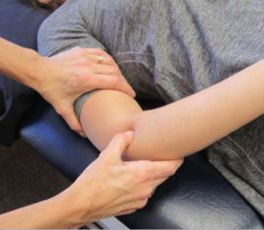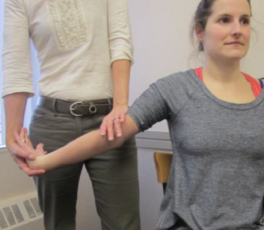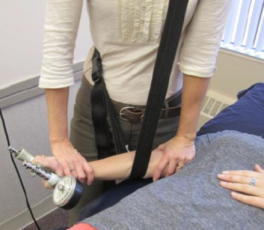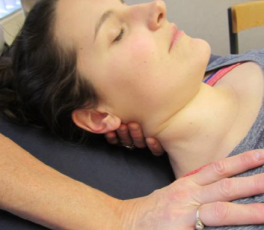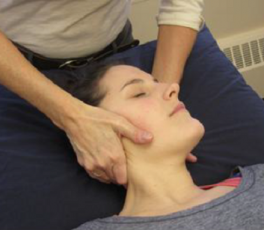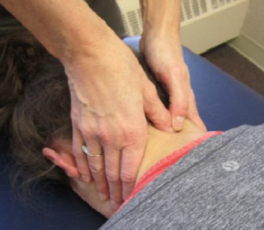Lateral Epicondyle Tendinopathy Toolkit: Section F - Manual Therapy: Difference between revisions
Kim Jackson (talk | contribs) No edit summary |
No edit summary |
||
| Line 224: | Line 224: | ||
[[Category:Clinical Guidelines]] | [[Category:Clinical Guidelines]] | ||
[[Category:Elbow - Guidelines]] | [[Category:Elbow - Guidelines]] | ||
[[Category:PT Knowledge Broker Project]] | |||
Revision as of 06:32, 22 October 2022
This article is currently under review and may not be up to date. Please come back soon to see the finished work! (22/10/2022)
Dr. Joseph Anthony, Paul Blazey, Dr. Allison Ezzat, Dr. Angela Fearon, Diana Hughes, Carol Kennedy, Dr. Alex Scott, Michael Yates and Alison Hoens
Top Contributors - Evan Thomas, Kim Jackson, Admin, Wanda van Niekerk, Rishika Babburu, 127.0.0.1 and Vidya Acharya
Manual Therapy[edit | edit source]
Manual therapy is a modality used in rehabilitation to assess and treat various conditions. The American Physical Therapy Association (APTA) describes manual therapy as “skilled hand movements intended to improve tissue extensibility, increase range of motion, induce relaxation, mobilize or manipulate soft tissue and joints, modulate pain, and reduce soft tissue swelling, inflammation, or restriction”. It describes hands-on techniques used in rehabilitation to treat various conditions, such as:
- Massage
- manual lymphatic drainage
- manual traction
- mobilisation/manipulation
- passive range of motion
Manual therapy is one of the oldest recorded modalities and over the years hit as seen many changes to its use and governance [Ref]. It's use in the assessment and treatment of epicondylitis is often advocated[ref].
In the acute stage there is minimal clinical evidence to support or refute the use of elbow mobilization in the acute stage. However, there is a large amount of clinical evidence supporting the use of elbow mobilizations, (MWM and Mill’s Manipulation). With some clinical evidence supporting the use of radial head mobilization and neural tension techniques. (For more information see Section D - Supporting Evidence)
There is weak support for the use of wrist-specific MWM to treat LET.
- MWM shows favorable outcomes for pain, grip strength and function.
- Mill’s manipulation demonstrated effectiveness for pain but not pain free grip strength. The use of Mill’s manipulation for improved function is unclear.
[INSERT TABLE FROM SECTION D - Supporting Evidence]
Cyriax-Type Physiotherapy Treatment[edit | edit source]
Cyriax and Cyriax suggested the use of deep transverse friction massage in combination with mill's manipulation for the treatment of tennis elbow[1]. In order to label the treatment intervention as Cyriax physiotherapy, both the treatment components mentioned above must be used jointly in the sequence specified. In this protocol, person must adhere to this intervention 3 times a week for duration of 4 weeks.[2] Figures 1 and 2 and the accompanying descriptions are the components of this treatment approach.
A study by Viswas et al 2012 found that Cyriax physiotherapy was effective in reducing pain associated with LET[3]
|
Deep Transverse Friction Massage (DTFM)
|
Figure 1 |
|
Mill’s Manipulation
|
Figure 2 |
Elbow Mobilization with Movement (MWM)[edit | edit source]
Mobilisations with movement is a manual therapy technique that forms part of the Mulligan Concept. MWM is the concurrent application of sustained accessory mobilization applied by a therapist and an active physiological movement to end range applied by the patient. Passive end-of-range overpressure, or stretching, is then delivered without pain as a barrier.
|
Figure 3 |
Spinal Mobilization/Manipulation[edit | edit source]
Spinal mobilization and manipulation are widely used techniques, where force is applied to the spinal joints, to treat pain in the extremities, back, and neck. Although the exact underlying mechanisms are not fully understood, itreatment of dysfunctional areas in the spine can restore the spine’s structural integrity, reduce pain and initiate the body’s natural healing processes. [ref]
|
Lateral Glide Mobilization (Vicenzino et al 1996[4])
|
Figure 4 |
|
Passive Intervertebral Mobilization (Cleland et al 2005[5]) Passive Physiological Mobilization
|
Figure 5 |
|
Passive Intervertebral Mobilization (Cleland et al 2005[5]) Passive Accessory Mobilization
|
Figure 6 |
|
Cervical Manipulative Thrust (Fernández-Carnero et al 2008[6])
|
Figure 7 |
Resources[edit | edit source]
- Click to go back to the Lateral Epicondyle Tendinopathy Toolkit page
- Click to continue to Section B - Clinical Assessment of LET
- Click to continue to Section C - Outcome Measures
- Click to continue to Section D - Summary of the Evidence
- Click to continue to Section E - Exercise Prescription
- Click to continue to Section G - LASER Dosage Calculation
- Click to continue to Section H - Braces, Splints and Taping
- UBC Lateral Epicondyle Tendinopathy Toolkit [LINK]
References[edit | edit source]
- ↑ Cyriax HJ, Cyriax JP. Cyriax's Illustrated Manual of Orthopaedic Medicine. Oxford, UK: Butterworth-Heinemann; 1983
- ↑ Stasinopoulos D, Johnson MI. Cyriax physiotherapy for tennis elbow/lateral epicondylitis. British Journal of Sports Medicine. 2004;38(6):675–677
- ↑ Viswas R, Ramachandran R, Korde Anantkumar P. Comparison of effectiveness of supervised exercise program and cyriax physiotherapy in patients with tennis elbow (lateral epicondylitis): a randomized clinical trial. The Scientific World Journal. 2012.
- ↑ Vicenzino B, Collins D, Wright A. The initial effects of a cervical spine manipulative physiotherapy treatment on the pain and dysfunction of lateral epicondylalgia. Pain. Nov 1996; 68(1): 69-74.
- ↑ 5.0 5.1 Cleland JA, Flynn TW, Palmer JA. Incorporation of manual therapy directed at the cervicothoracic spine in patients with lateral epicondylalgia: a pilot clinical trial. Journal of Manual & Manipulative Therapy. 2005; 13(3): 143-151.
- ↑ Fernández-Carnero J, Fernández-De-Las-Peñas C, et al. Immediate hypoalgesic and motor effects after a single cervical manipulation in subjects with lateral epicondylalgia. Journal of Manual & Manipulative Therapy. 2008; 31(9): 675-681.
